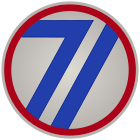71st Infantry Division (United States)
|
71th Infantry Division |
|
|---|---|
 Division badge |
|
| active | 1943 to 1956 |
| Country |
|
| Armed forces | United States Armed Forces |
| Armed forces | United States Army |
| Branch of service | infantry |
| Type | Infantry division |
| Nickname | The Red Circle |
| Butcher | Second World War |
The 71st Infantry Division ( German 71st US Infantry Division ) was a major unit of the US Army in World War II and the Cold War .
history
The division was established on July 15, 1943 in Camp Carson, Colorado . Since the division's 14th Infantry Regiment was previously stationed on the Panama Canal and had some experience in jungle combat, the unit was only to be used against the Japanese in the Pacific War . However, after the division was trained, this plan was discarded. On January 26, 1945, the division was sent to France and landed in Le Havre on February 6 . Further training units followed before the soldiers in March in the section of the 7th US Army at the XV. Corps came to the front. In the fight against the Wehrmacht it was possible to break through the west wall ; Pirmasens was occupied on March 22nd. After crossing the Rhine on March 30th, it was via Coburg on today's federal highway 9 . During the advance to Franconia , Bayreuth was occupied on the afternoon of April 14th. Further south, after crossing the Naab, Kallmünz was reached on April 24th. Two days later, on April 26th, the step across the Danube followed . They had already arrived in Regensburg on April 25 , where the Stadtamhof district was first occupied. On April 27, the entire city was handed over to the Americans by the combat commander. The capture of Straubing followed on April 28th . A little later the Isar could be crossed before the border to Austria , part of the German Reich since 1938, was crossed on May 2nd . On May 4, was in Upper Austria , the satellite camp Gunskirchen , a subcamp of the Mauthausen concentration camp liberated. Together with employees of the Red Cross , the over 5,000 detainees found were cared for; thousands more dead were found in mass graves. In May 1945 the division had a book published with reports and photos of the liberation in order to document what happened there. Since 1979 a memorial stone has been commemorating the liberation of the camp.
The division was last the XX. Corps subordinated to the 3rd US Army and reached the Enns , where it met the Red Army on May 8, east of Linz . After the end of the war, the division remained as an occupying force in Europe until it returned to the USA and was deactivated there. 243 soldiers of the division were killed in action, 843 were wounded. One of the soldiers who served in the 71st Infantry Division in the war was John Eisenhower , son of General and later US President Dwight D. Eisenhower . The last commanding officer of the division was William Westmoreland , later commander in chief of the US Army in the Vietnam War .
In 1954 the division was reactivated briefly. The association was stationed in Alaska , but was disbanded in 1956 without having completed any further combat missions.
organization
The 71st Infantry Division was divided into the following units:
- 5th Infantry Regiment
- 14th Infantry Regiment
- 66th Infantry Regiment
- Artillery Division
- 564th Field Artillery Battalion
- 607th Field Artillery Battalion
- 608th Field Artillery Battalion
- 609th Field Artillery Battalion
- 571st Signal Company
- 771st Ordnance Company
- 251st Quartermaster Company
- 71st Reconnaissance Troop
- 271st Engineer Battalion
- 371st Medical Battalion
- 71st CIC Detachment
Division commanders
- Brigadier General Robert L. Spragins, July 1943-October 1944
- Major General Eugene M. Landrum, October-November 1944
- Major General Willard G. Wyman, November 1944 - August 16, 1945
- Brigadier General Onslow S. Rolfe, August 17, 1945 - October 10, 1945
- Major General Arthur A. White, October 11, 1945 - February 1946
Web links
Individual evidence
- ↑ Joachim Brückner: End of War in Bavaria 1945 , Verlag Rombach Freiburg, 1987, p. 154.
- ^ Daniel Blatman: The Death Marches 1944/45. The last chapter of the National Socialist mass murder . Reinbek / Hamburg 2011, ISBN 978-3-498-02127-6 , p. 392.
- ^ The 71st Infantry at Gunskirchen Lager
